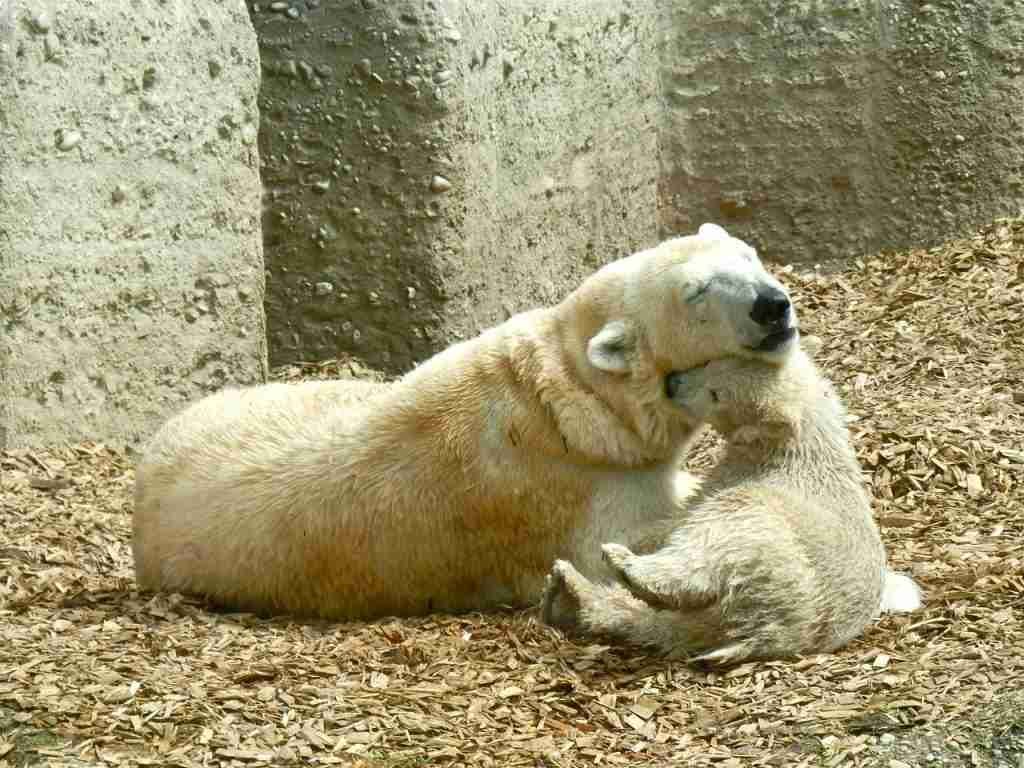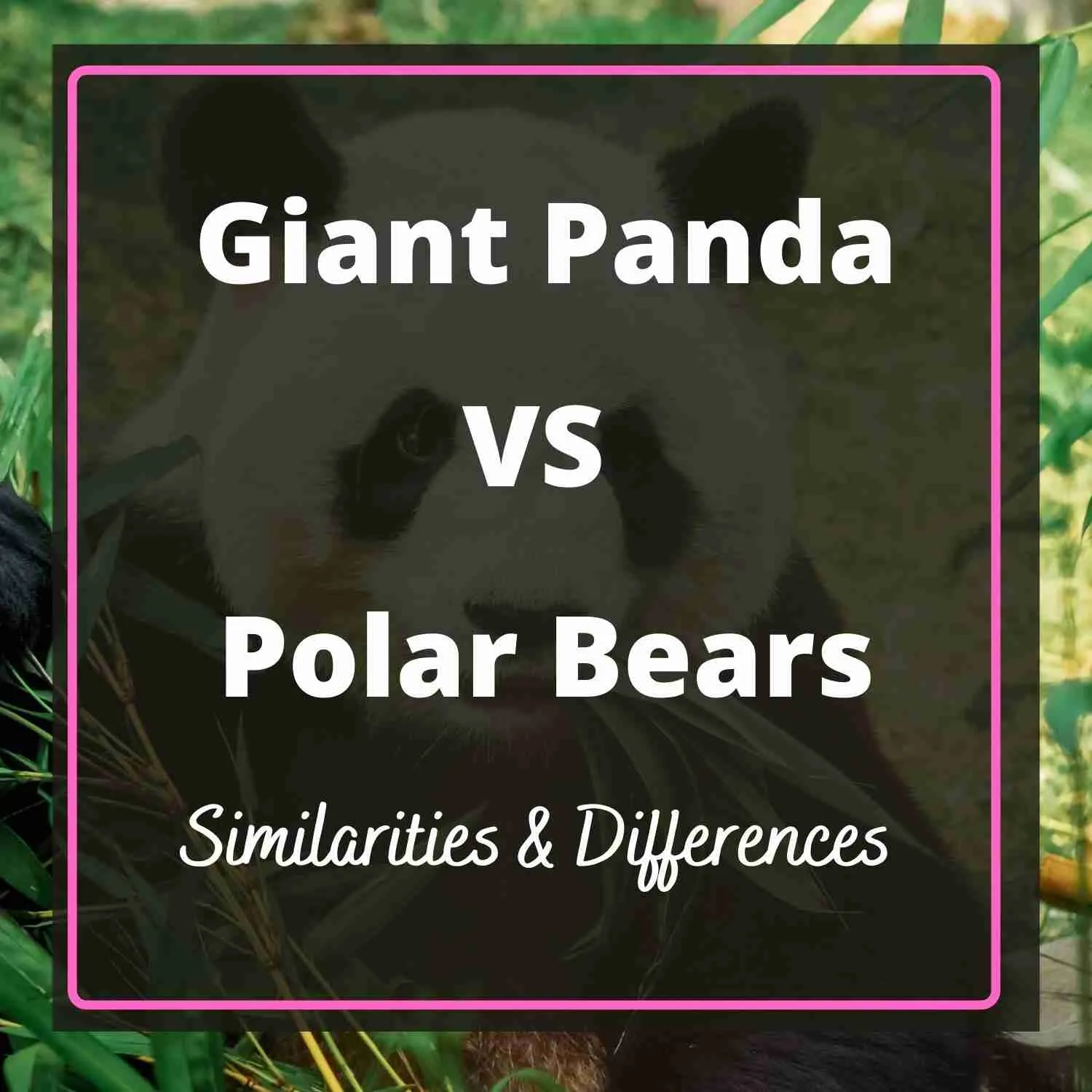Take your time to watch the giant pandas and the polar bears in their habitats. Here’s one thing you’ll notice about both animals – cuteness runs in their genes!
Even though the panda bears and the polar bears share certain similarities, they are different. In swimming, for example, the polar bears are better than the pandas.
Let’s just say nature has designed these two animal species to survive in their different environments. So it will be unfair to say that one animal is better than the other.
Now, what are the similarities and differences between the giant panda and the polar bear? Keep on reading to find out!
Here’s a summary of the characteristics of both animal species:
Similarities & Differences (Summary)
| Giant Panda | Polar Bear | |
| Life Span | 20 years | 25 – 30 years |
| Size | 1.97 – 2.95 ft (60 – 90 cm) | 5.91 – 7.87 ft (1.8 – 2.4 m) |
| Weight | 154.3 – 265 lbs (70 -120 kg) | 331 – 551lbs (150 -250 kg) |
| Population | 1,864 | 22,000 – 31,000 |
| Diet (Food) | Bamboo | Ringed seal |
| Strength | 292 psi | 1235 psi |
| Location | Bamboo Forests | Arctic sea ice |
| Offspring | 1 – 2 at once | 1 – 2 at once |
Life Span
While in the wild, the panda bears can live up to 15 years and in captivity, they can live for 20 years. In captivity, a polar bear can live up to 23 years and can live for around 30 years in the wild.
Nevertheless, there can be exceptions.
Some polar bears live longer than 30 years. An example is Snow Lilly which is considered the oldest polar bear to live in captivity. She died at age 36.
An An is also an example of a giant panda that lived longer than most pandas. He turned 35 in August 2021. He is currently considered the longest-living panda in captivity.
Diets, comfortable habitats, freedom from predators, and adequate care are factors that contribute to long life in the animal species.
Size
Compared to pandas, polar bears are bigger and larger. When on all fours, the polar bears are usually between 3.5 to 5 feet tall.
Whereas, the giant pandas are usually between 2 and 3 feet when on all fours.
Generally, sea bears are known as the biggest land carnivore. They are also the largest bear species in the world. Despite their large sizes, the polar bears are great swimmers.
So it is fair to say that between the two bear species, the polar bears are the ‘winner’ in terms of size.
Weight
Commonly, an adult polar bear weighs between 331- 551lbs(150 -250 kg)
while the adult panda weighs between 154.3- 265 lbs(70 -120 kg).
Female polar bears weigh between 330 and 650 lbs (197.7 – 249.8 kg) while the males weigh between 770 and 1300 lbs (349.3 – 589-7 kg).
On the other hand, the male giant pandas can weigh about 250 pounds. Since the female pandas are usually smaller than males, they can weigh up to 220 pounds.
Understand that these giant pandas are not small animals. They are just not as big as the marine mammals – the polar bears.
Population
As of now, the panda bears’ population is 1,864 while the polar bears’ population is between 22,000 and 31,000.
A few years back, both animals were considered as endangered species by the IUCN because of man’s constant attacks. Presently, the pandas’ population is now among the list of vulnerable species.
Thanks to China for its regular conservation effort, the panda bears would have become extinct.
Among the Chinese conservation programs is restoring the giant pandas’ habitat and loaning the bears to different countries.
In addition, the government set up strict laws against the illegal hunting of panda bears.
Although there have been improvements, the panda bears still need to be protected. However, there is hope that the number of these animals will continue to increase.
Climate change is the main problem affecting the polar bears’ population. As a result of global warming, their habitats, the Arctic sea ice, are always at risk of melting.
Whenever their habitat is affected, the marine mammals are usually exposed to hunting by man.
Like China, the Canadian government is actively involved in protecting these animals from hunting by man.
Diet (Food)

Bamboo is the primary diet of the giant pandas while the sea bears eat seals most times.
Among all bears, only the panda bears feed like herbivores. They spend the majority of their days eating this diet and sleeping.
That’s why these pandas are usually found in bamboo forests, especially in China.
Once in a while, the pandas eat small rodents, eggs, and fish.
Being carnivores, polar bears eat seals primarily. Perhaps because of their weight, the sea bears are not skillful at running after their prey.
So they just silently stay on the ice to catch any seal that comes out of the sea.
Sometimes, they feed on birds and their eggs too.
Strength
In terms of strength, polar bears are stronger than giant pandas.
However, the panda bears are not entirely weak animals. They have strong teeth and jaw muscles for defending themselves against predators.
And no matter how hard a bamboo plant is, these cute animals can crush it into pieces.
Due to their size and weight, the polar bears have more strength than giant pandas. Running can be a great task for these sea bears but they swim perfectly well.
Location
Giant pandas live in the mountainous bamboo forests in China while the polar bears live in the cold Arctic regions.
One major reason the panda bears live in these habitats is because of their favorite diet – bamboo. They eat about 26 to 84 pounds of the bamboo diet every day.
Another factor that determines where the pandas live is height and weather. Since they lead solitary lives, these bears love staying alone in tall trees and cold mountains.
Fortunately, nature has made it easy for these giant pandas to survive in their habitats. They have thick furs that keep them warm during cold seasons.
Moreover, these pandas have “false thumbs” that help them cut and hold the bamboo in their hands.
Same as the giant pandas, the polar bears love cold environments too. They live in the cold Arctic region on waters full of ice. These marine mammals also breed, sleep and hunt seals in these icy environments.
No doubt, not all animals can survive in the cold like the polar bears. They have thick layers of fat and fur to keep warm during the cold.
Their coats are also greasy and shed off water to prevent heat loss.
Furthermore, polar bears have large feet that allow body balance while walking or running on ice.
Offspring

Oftentimes, a giant panda gives birth to one or two cubs at once. Just like the panda bears, the polar bears give birth to one to two cubs at once too.
Both animal species are almost similar in the area of reproduction.
Between ages 4 to 8, a giant panda becomes sexually mature. Although, the female panda can only get pregnant around 2 to 3 days a year.
Both the male and female giant pandas are slow breeders.
Females attract the males with their scents and funny sounds. After mating, both animals go their separate ways.
Before delivering her babies, the female panda builds a nest with dry grass and tree branches to house her cubs. It is commonly located inside a hollow tree or natural dens.
Commonly, the panda gives birth to 1 or 2 cubs at a time. But she focuses her attention on only one of the babies.
Newborn pandas are always very tiny. They can weigh between 3 to 5 ounces.
Similar to the giant pandas, the polar bears are also solitary animals. However, the males look for females, especially in early summer.
Around age 4 to 5, the female polar bears reach sexual maturity. Usually, the males sexually mature between ages 8 to 10.
Female polar bears attract the males with their scents. Sometimes, two males can fight over a female in the area of mating.
Unlike other mammals, female marine mammals only release eggs after intercourse. Besides, pregnancy doesn’t happen immediately- it may take several trials.
After around eight months, the female sea bear gives birth to two small cubs. Like the panda bears, the female polar bear delivers her babies in the cave.
They often weigh 2 kilograms at birth. Also, these babies are usually blind with thin furs and no teeth.
Related Questions:
Panda vs. Polar Bear – Who Would Win?
Considering their larger sizes, the polar bears would win the fight. Don’t forget that the average weight of an adult giant panda is between 154.3- 265 lbs(70 -120 kg). In contrast, the average weight of an adult polar bear is 331 – 551lbs (150 -250 kg).
Keep in mind that the panda bears are not weak animals. They have strong teeth and jaw muscles that can crush hard bamboo to bits.
However, they don’t stand a chance with the polar bears.
Although these pandas will possibly harm the marine mammals in some ways, they won’t win.
Are Giant Pandas Bigger Than Polar Bears?

No, giant pandas are not bigger than polar bears. In fact, they are very small compared to the sea bears.
In terms of height, the polar bears are usually between 3.5 to 5 feet tall. Whereas, the giant pandas are usually between 2 to 3 feet when on all fours.
As regards weight, the giant panda can weigh up to 265 lbs(120 kg) while the polar bear can weigh about 551lbs (250 kg).
So from all the indications, the panda bears are smaller than the polar bears.
Are Polar Bears And Pandas The Same?
No, the polar bears and the pandas are not the same. Both species of animals are a type of bear, and they are both solitary animals.
Although these animals have also experienced habitat loss at one time and are considered endangered species, they are different.
They differ in size, habitats, strength, diets, lifespan, and more.
Is There A Panda Polar Bear Hybrid?
No, there is presently no panda polar bear hybrid. Panda polar bear hybrid means the breeding of both animal species to produce offspring.
Giant pandas are not able to produce hybrids with other bears as of now. With the continual improvement in technology, there might be positive results in the future.
Conclusion
Before we wrap up, here’s all we’ve discussed in this article.
Panda bears and polar bears are similar in some ways, but they are also different.
In size, giant pandas are smaller than polar bears. In the area of population, the Chinese government is actively protecting the pandas while the Canadian government is protecting the polar bears.
Giant pandas live in mountainous habitats, especially in China while the polar bears live in the cold Arctic region.
In terms of diets, the panda bears love eating bamboo while the sea bears love eating seals.
While the panda bears are skilled at climbing trees, the polar bears are excellent swimmers. Despite their differences, the panda and the polar bears are both amazing creatures.
Did you find this article helpful? Share with friends on social media!

